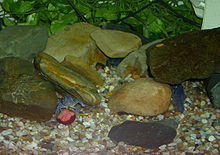Florida blue cancer
| Florida blue cancer | ||||||||||||
|---|---|---|---|---|---|---|---|---|---|---|---|---|

Florida blue crab ( Procambarus alleni ) |
||||||||||||
| Systematics | ||||||||||||
|
||||||||||||
| Scientific name | ||||||||||||
| Procambarus alleni | ||||||||||||
| ( Faxon , 1884) |
The Florida blue crab ( Procambarus alleni ) is mainly native to Florida . It is a crab that is kept comparatively often in aquariums.
Appearance
The Procambarus alleni grows between 10 and 12 cm, but there are also some specimens that can reach a length of 15 cm. It is usually brown in color, but a blue variant is almost exclusively used in aquaristics. This is where the common name "Blue Florida Crab" comes from.
Sexual characteristics
In the plan view Procambarus alleni almost indistinguishable in sex. The best way to tell the sex is to turn the animal on its back. In males there is a genital organ on the caudal fin, which is absent in females. In addition, one pair of scissors is larger in females than the other - but males can also have two scissors of different sizes if they have grown back after a fight, so sex determination based on the differences in scissors is very imprecise.
Females must be larger than males to mate. Females are sexually mature from a size of approx. 3.5 cm. Depending on the size, strength and vitality of the female, they give birth to 50 to 100 young animals.
habitat
Procambarus alleni prefers stagnant water or only very weakly flowing rivers. If the water level drops, it digs into the ground. It mainly inhabits the area east of the St. Johns River and the entire southern peninsula of Florida .
nutrition
In the wild, it feeds mainly on aquatic plants, fish owls, as well as living small fish and leaves that have fallen into the water. Like most crabs, it is also a robber of opportunity. There are food tablets for keeping the aquarium. In the aquarium, crabs also like to eat carrots, cucumber or frozen peas.
growth
Like all other crustaceans, Procambarus alleni has to molt in order to grow. The molt is a dangerous endeavor for any cancer, and if it gets stuck in its shell it can die. You can tell a few days in advance that your cancer will shed its skin. A sign of this is that it hides more and eats less so that it can draw the nutrients from its old shell. In the next step the armor pops up between the head-chest piece and the abdomen. Then the crab pumps water into the shell and continues to blow it up. With rhythmic blows with his tail fin he strips off the shell. The shell is still very soft for the first few days after molting. One then speaks of the so-called "butter crab".
Keeping in the aquarium
Due to its size, the Florida blue crab can be kept alone in an aquarium with a length of 60 cm. The crab needs hiding places and enough gravel to dig. He is very fond of climbing and nibbles on all real plants. It is quite possible that P. alleni eats inedible plants such as Anubias or Microsorum. Attacks on fish are also not uncommon, especially with smaller fish that sleep near the bottom. Attacks on plants and fish seem to be temperature-dependent to a large extent, as elevated temperatures increase the animals' appetite considerably. If you want to keep a male and a female, the tank should be at least three feet long. It is important that the Procambarus alleni , unlike the Procambarus clarkii, always has clean water and the temperature should always be between 20 and 24 degrees.
literature
- Hans Gonella: Crabs, crabs and prawns in the freshwater aquarium . Bede, 1999, ISBN 3-931792-87-0 .
- Chris Lukhaup: Freshwater crabs from all over the world . 2nd edition, Ettlingen 2008, ISBN 978-3-935175-40-1 .
- Chris Lukhaup & Reinhard Pekny: Crabs in the aquarium . 2nd edition, Ettlingen 2008, ISBN 978-3-935175-31-9 .
Web links
- Procambarus alleni inthe IUCN 2013 Red List of Threatened Species . Listed by: Crandall, KA, 2010. Retrieved January 19, 2014.
